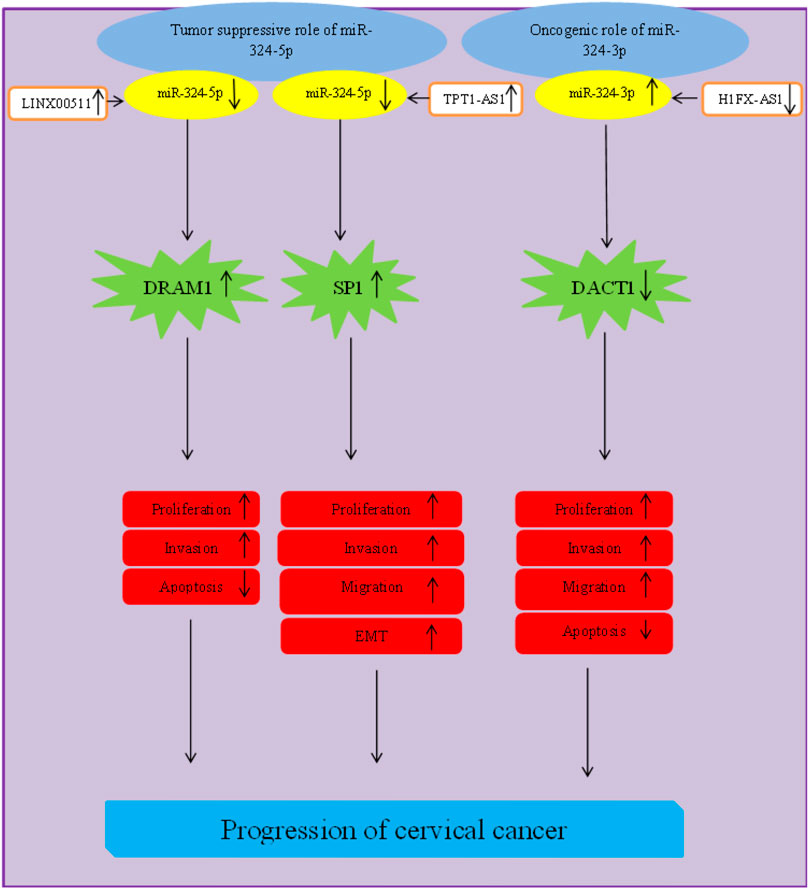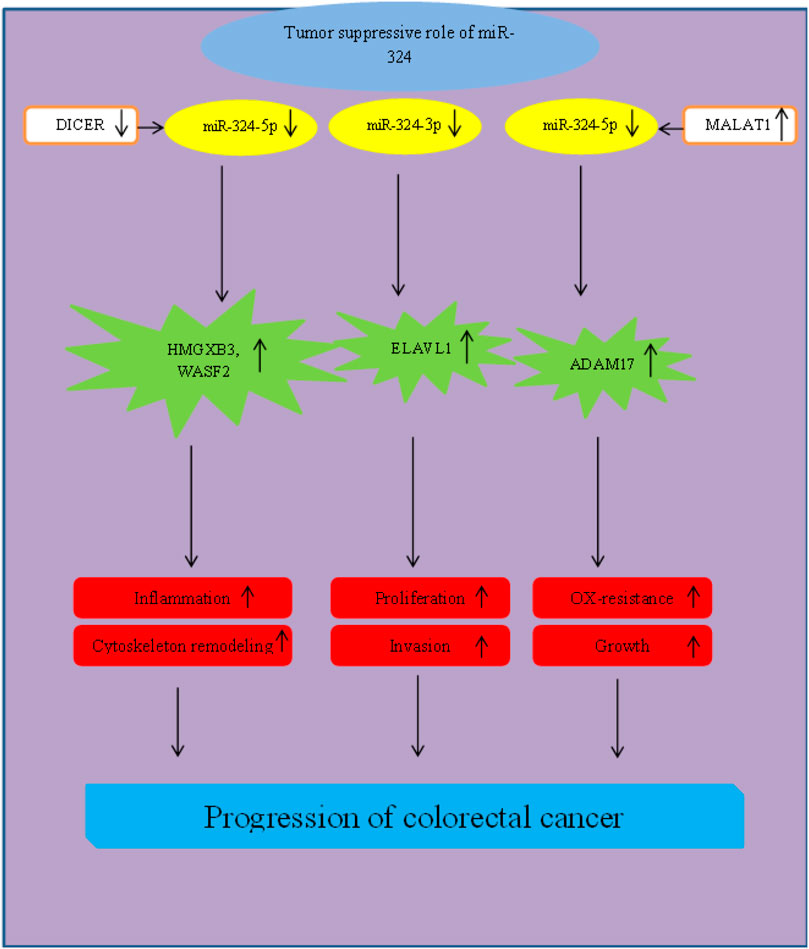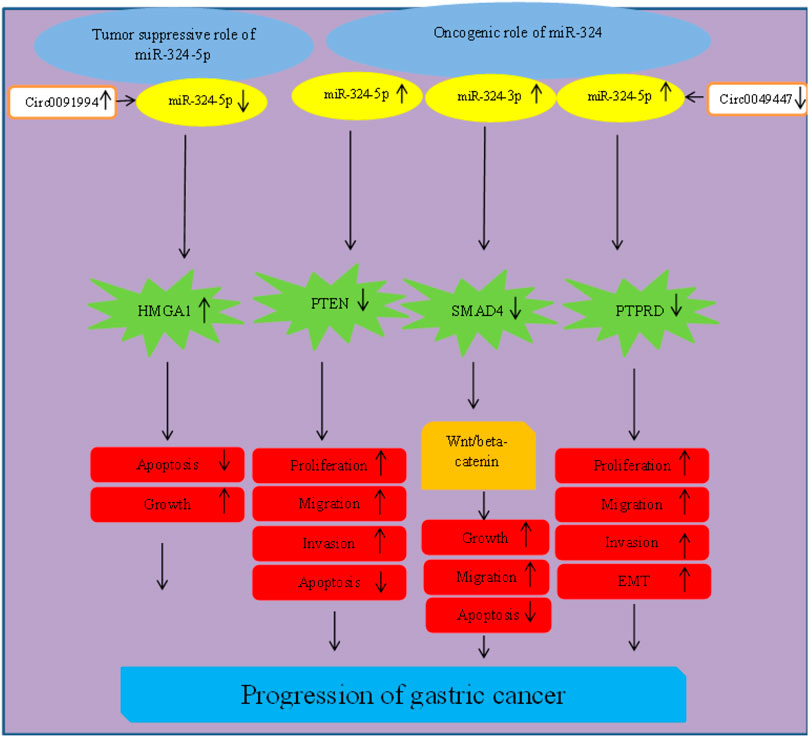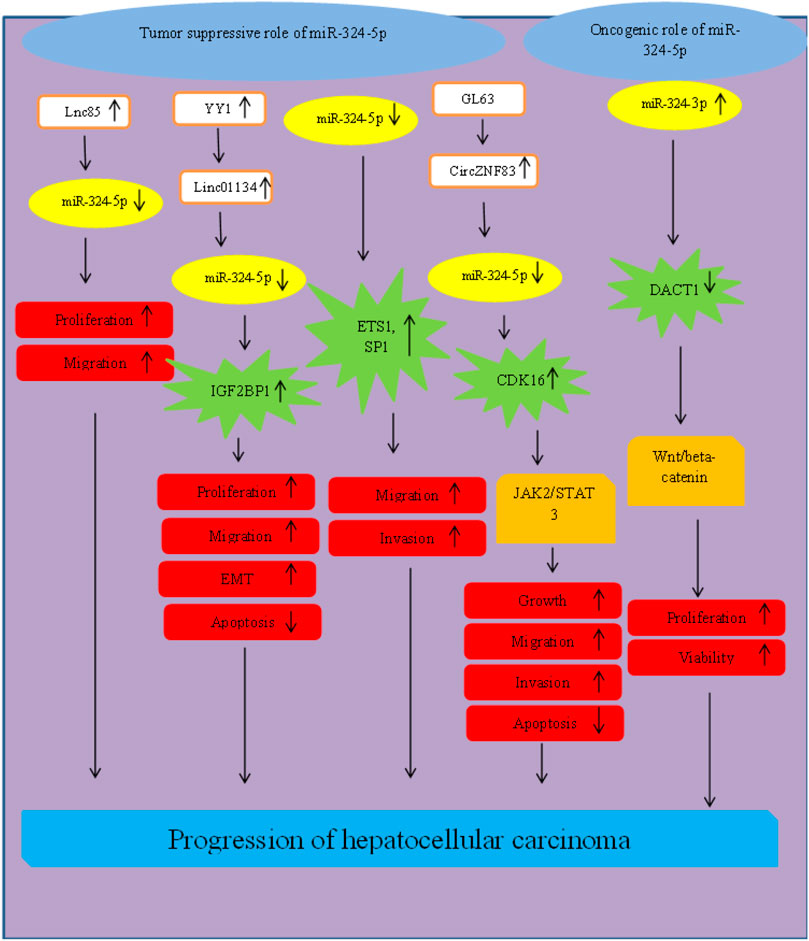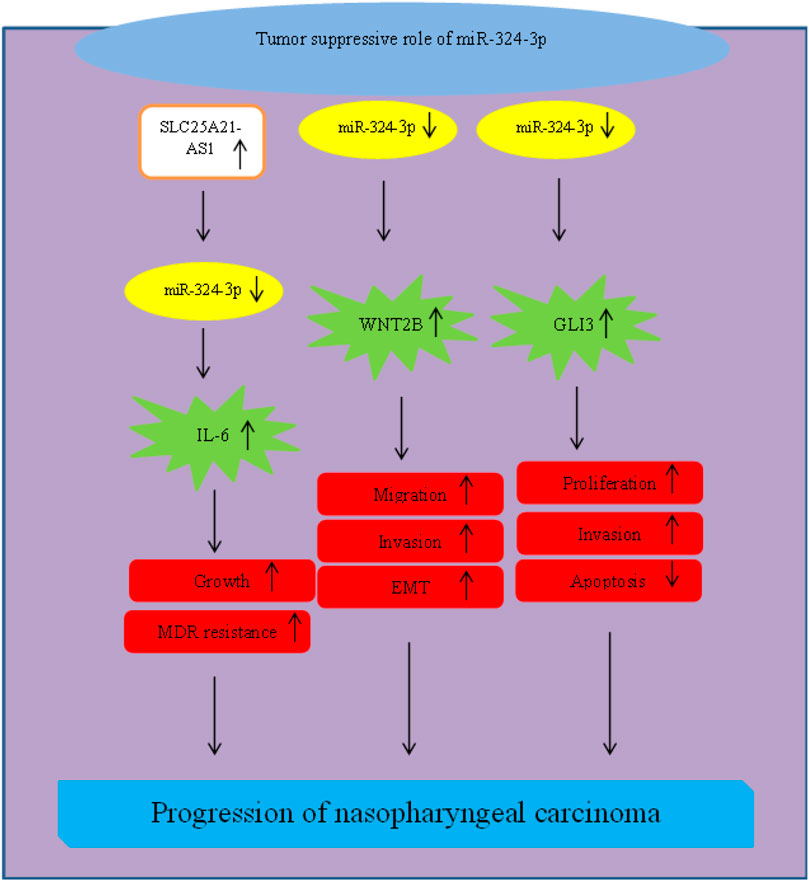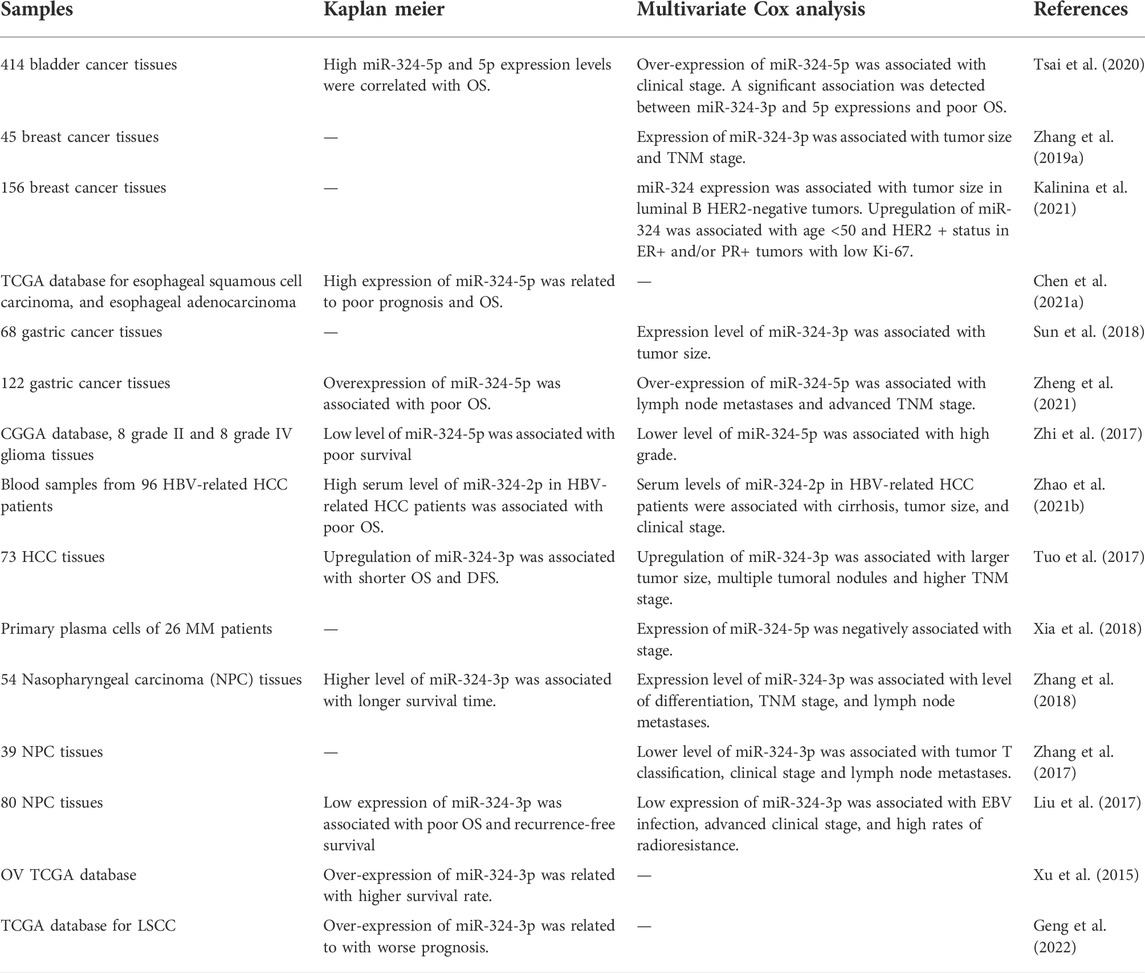- 1Department of Medical Genetics, School of Medicine, Tehran University of Medical Sciences, Tehran, Iran
- 2Department of Pharmacognosy, College of Pharmacy, Hawler Medical University, Erbil, Iraq
- 3Center of Research and Strategic Studies, Lebanese French University, Erbil, Iraq
- 4Department of Medical Biotechnology, School of Medicine, Alborz University of Medical Sciences, Karaj, Iran
- 5Dietary Supplements and Probiotic Research Center, Alborz University of Medical Sciences, Karaj, Iran
- 6Department of Medical Genetics, Shahid Beheshti University of Medical Sciences, Tehran, Iran
Recent studies have revealed important functions of several microRNAs (miRNAs) in the pathogenesis of human diseases. miR-324 is an example of miRNAs with crucial impacts on the pathogenesis of a wide range of disorders. Gene ontology studies have indicated possible role of miR-324 in responses of cells to the leukemia inhibitory factor, long-term synaptic potentiation, positive regulation of cytokines production and sensory perception of sound. In human, miR-324 is encoded by MIR324 gene which resides on chromosome 17p13.1. In the current manuscript, we provide a concise review of the role of miR-324 in the pathogenesis of cancers as well as non-cancerous conditions such as aneurysmal subarachnoid hemorrhage, diabetic nephropathy, epilepsy, pulmonary/renal fibrosis, ischemic stroke and ischemia reperfusion injuries. Moreover, we summarize the role of this miRNA as a prognostic marker for malignant disorders.
Introduction
MicroRNAs (miRNAs) are small regulatory molecules that have principal roles in several cellular processes. They DNA sequences coding these transcripts are mainly transcribed into primary miRNAs. Primary miRNAs are then processed into the precursor and mature miRNAs through a multistep process. miRNAs principally affect genes expression through binding with the 3′ UTR of the target mRNAs. This interaction induces degradation of mRNAs or repression of their translation. In some cases, miRNAs can interact with 5′ UTR or even coding or promoter regions (O'Brien et al., 2018). Notably, the interplay between miRNAs and their targets is dynamic. It depends on subcellular localization of miRNAs, quantities of both miRNAs and target transcripts, and the affinity of miRNA-target interaction which is mainly determined by the mode of base pairing (O'Brien et al., 2018).
miR-324 is an example of miRNAs with crucial impacts on the pathogenesis of human disorders. This miRNA participates in gene silencing. Gene ontology studies have indicated possible role of miR-324 in diverse processes, namely responses of cells to the leukemia inhibitory factor, long-term synaptic potentiation, positive regulation of cytokines production and sensory perception of sound (https://www.ncbi.nlm.nih.gov/gene/442898). In human, miR-324 is encoded by MIR324 gene which is located on chromosome 17p13.1.
Through interaction with a variety of RNA molecules, miR-324 participates in the etiopathology of several cancers as well as non-cancerous disorders such as aneurysmal subarachnoid hemorrhage, anorectal malformation, cardiac diseases, diabetic nephropathy, epilepsy, HIV lipodystrophy, idiopathic pulmonary fibrosis, ischemic stroke, myocardial ischemia reperfusion (I/R) injuries, nerve injury, osteoarthritis, Parkinson’s disease, polycystic ovarian syndrome, renal fibrosis and thermal injury.
In the current manuscript, we provide a concise review of the role of miR-324 in the pathogenesis of mentioned disorders. Moreover, we summarize the role of this miRNA as a prognostic marker for malignant disorders.
Role of miR-324 in cancers
Cervical cancer
Cervical cancer is an example of cancers in which miR-324 is dysregulated. However, different studies in this type of cancer have reported inconsistent results regarding the pattern of expression and exact role of miR-324 in cervical cancer. This inconsistency might be explained by different roles of miR-324-5p and miR-324-3p. Zhang et al. (2020) have shown that upregulation of the cytoplasmic long non-coding RNA (lncRNA) LINC00511 leads to downregulation of miR-324 in cervical cancer cell lines. DRAM1 has been identified as a target of miR-324 in these cells. Both miR-324-5p mimics and LINC00511 targeting siRNAs reverse the oncogenic effects of DRAM1 on cervical cancer cells. Cumulatively, LINC00511 has been found to act as a competing endogenous RNA (ceRNA). This lncRNA regulates activity of miR-324-5p/DRAM1 axis and promotes progression of cervical cancer irrespective of the presence of HPV (Zhang et al., 2020). Similarly, through gain- and loss- experiments, Jiang et al. have shown that miR-324-5p inhibits colony construction, proliferative ability, migration, invasive properties and epithelial-mesenchymal transition (EMT) in cervical cancer. The sponging effect of TPT1-AS1 on miR-324-5p leads to enhancement of cell growth and metastases in this type of cancer (Jiang et al., 2018).
Conversely, Shi et al. (2020) have reported upregulation of miR-324 in cervical cancer cells and clinical samples. They have also shown that the tumor suppressor lncRNA H1FX-AS1 acts as a ceRNA for miR-324-3p to surge expression of DACT1 (Shi et al., 2020). Figure 1 shows the impact of miR-324 in cervical carcinogenesis.
Colorectal cancer
In colorectal cancer, both miR-324-5p (Huang et al., 2022) and miR-324-3p (Xiao et al., 2019) have been found to be downregulated. An in vitro study in colorectal cancer cells has shown the sponging effects of VPS9D1-AS1 on miR-324-5p and demonstrated this mechanism as the underlying cause of downregulation of miR-324-5p in these cells. In line with the observed targeting of ITGA2 3′ UTR by miR-324-5p targets, miR-324-5p knock-down or forced over-expression of ITGA2 has reduced the impact of VPS9D1-AS1 silencing in colorectal cancer cells. Taken together, VPS9D1-AS1/miR-324-5p/ITGA2 axis has been reported to affect pathogenesis of colorectal cancer (Huang et al., 2022). Another study has confirmed the role of Dicer in the regulation of expression of miR-324. Assessment of expression profile of colorectal cancer cell lines as well as intestinal epithelial cells of mice has shown significant reduction of miR-324-5p expression after deletion of Dicer. miR-324-5p has been shown to bind to the 3′ UTRs of HMGXB3 and WASF-2, two important molecules with essential roles in cell motility and cytoskeleton remodeling. Intraperitoneal administration of a miR-324-5p agonist has reduced chronic inflammatory responses and cytoskeleton remodeling of colorectal epithelial cells and reestablished intestinal barrier integrity in Dicer-deleted cells of mice. Cumulatively, DICER/miR-324-5p/HMGXB3/WASF-2 axis has been found to affect colorectal tumorigenesis through modulation of cytoskeleton remodeling and intestinal barrier function (Sun et al., 2017). MALAT1/miR-324-3p/ADAM17 (Fan et al., 2020) and miR-324-3p/ELAVL1 (Xiao et al., 2019) axes are two other molecular axes participating in the pathogenesis of colorectal cancer (Figure 2).
Gastric cancer
In gastric cancer, two different studies have reported upregulation of miR-324-5p (Tang et al., 2021a; Zheng et al., 2021), while another study has reported downregulation of this miRNA (Xie et al., 2021). miR-324-3p has also been reported to be upregulated in gastric cancer tissues (Sun et al., 2018). Circ0049447/miR-324-5p (Tang et al., 2021a) and Circ0091994/miR-324-5p/HMGA1 (Xie et al., 2021) axes have been shown to affect gastric tumorigenesis (Figure 3).
Brain tumors
Different experiments in brain tumors have confirmed tumor suppressor role of miR-324. For instance, SERPINE2 has been found to induce proliferation of glioblastoma cells and inhibit their apoptosis via influencing activity of miR-324-5p/BCL2 axis (Li et al., 2021). Moreover, the oncogenic lncRNA NEAT1 promotes progression of glioma through sponging miR-324-5p and inducing expression of KCTD20 (Zhang et al., 2021). Finally, miR-324-5p could hamper cell proliferation and Temozolomide (TMZ) resistance via targeting EZH2 (Zhi et al., 2017) (Figure 4).
Hepatocellular carcinoma
In hepatocellular carcinoma, miR-324-5p has been shown to be downregulated (Huang et al., 2020a), while miR-324-3p has been upregulated (Tuo et al., 2017). Comprehensive assessment of expression profile of plasma exosomes in patients with hepatocellular carcinoma has led to identification of a novel differentially expressed lncRNA, namely RP11-85G21.1 (lnc85) which has been shown to promote proliferation and migration of hepatocellular carcinoma cells through binding with miR-324-5p (Huang et al., 2020a). CircZNF83/miR-324-5p/CDK16 (Zhao et al., 2021a), LINC00491/miR-324-5p/ROCK1 (Wan g et al., 2021) and YY1/linc01134/miR-324-5p/IGF2BP1 (Rong et al., 2020) are other molecular axes that influence pathogenesis of this type of cancer (Figure 5).
Other types of cancer
In nasopharyngeal carcinoma, miR-324-3p has been shown to exert a tumor suppressor role. This miRNA could exert this effect through targeting GLI3 (Zhang et al., 2017), WNT2B (Liu et al., 2017) and SMAD7 (Xu et al., 2015). Moreover, the oncogenic role of SLC25A21-AS1 in this type of cancer has been found to be exerted through sponging miR-324-3p and increasing expression of IL-6 (Wang et al., 2020a) (Figure 6).
Studies in other types of cancers have also indicated importance of miR-324 in the evolution and progression of cancer (Table 1).

TABLE 1. miR-324 in cancers (ANCS, adjacent non-cancerous sample; OX, oxaliplatin; TMZ, temozolomide; MDR, multidrug resistance; FNA, fine needle aspiration; LNM, lymph node metastasis).
The impact of miR-324 on therapeutic response
In addition, miR-324 participates in the response of cancer cells to therapeutic agents. For instance, according to Wu et al. study on HEK-293, PC9, HCC827 cell lines and mice model of lung cancer, lncRNA APCDD1L-AS1 via regulation of miR-1322/miR-1972/miR-324-3p/SIRT5 axis could cause upregulation of EGFR and induce resistance to icotinib (Wu et al., 2021).
The prognostic role of miR-324 in cancers
The impact of dysregulation of miR-324 in tumor tissues on patients' survival has been assessed through Kaplan-Meier analysis. Moreover, multivariate Cox analysis has shown association between expression levels of miR-324 and clinical data (Table 2). For instance, miR-324 has been among miRNA whose expression levels in breast cancer tissues have been associated with tumor size or lymph node involvement depending on the status and expression levels of hormone receptors, HER2, and Ki-67 (Kalinina et al., 2021). In bladder cancer, over-expression of miR-324-5p has been associated with clinical stage. Besides, significant associations have been observed between high miR-324-3p and miR-324-5p expression levels and poor overall survival (Tsai et al., 2020). On the other hand, in glioma samples, lower level of miR-324-5p has been associated with high grade (grade III and grade IV) (Zhi et al., 2017).
Role of miR-324 in non-malignant disorders
miR-324 has been among dysregulated miRNAs in aneurysmal subarachnoid hemorrhage (SAH) patients. Notably, miR-324-3p has been shown to be upregulated in SAH patients with delayed cerebral infarction (DCI) as well as non-DCI group. Yet, no significant difference has been detected in expression levels between patients with and without DCI (Su et al., 2015). Another investigation has revealed importance of miR-324-3p in the pathogenesis of anorectal malformations and demonstrated that Rno_circ_0005139 can increase cell proliferation and apoptosis via influencing activity of miR-324-3p/Wnt5a axis (Liu et al., 2020a). In the context of cardiac disorders, NFAT4 has been shown to regulate miR-324-5p/Mtfr1 axis to enhance mitochondrial fission and cardiomyocyte apoptosis and aggravate pathogenic events in the myocardial infarction (Wang et al., 2015). Table 3 summarizes the impact of miR-324 in the pathogenesis of non-neoplastic conditions.

TABLE 3. miR-324 in non-malignant diseases (DCI, Delayed cerebral infarction; IEC, intestinal epithelial cells; MCD, minimal change disease; HG, high glucose; Ucn, Urocortin; OGD/R, oxygen-glucose deprivation/reoxygenation; NOF, neck of the femur; EX, aerobic exercise; SED, sedentary).
Liu et al. (2021) have examined miR-324-3p expression levels in primary Granulosa cells (GCs) retrieved from the follicles of ovarian tissue in the follicular phase from high- and low-yielding goats and found that upregulation of chi-miR-324-3p can inhibit GCs proliferation via targeting DENND1A gene and consequently downregulating expression of GCs proliferation markers such as LHR, cyclin D2, and CDK4 (Liu et al., 2021).
The importance of miR-324 in skeletal muscle differentiation has been investigated in different studies. According to Liu et al. (2020b) study in mice models, mouse C2C12 myoblasts and human HEK293T cell line, miR-324-5p has been over-expressed in skeletal muscle. Through targeting lncDum and Pm20d1, this miRNA could inhibit myoblasts differentiation and lipid aggregation (Liu et al., 2020b).
In the bone remodeling process in the body, small extracellular vesicles (sEVs) secreted by mature osteoclasts play an important role. One of the upregulated miRNAs in sEVs is miR-324. This miRNA that could cause differentiation and mineralization of bone progenitor cells by through silencing of ARHGAP1 and subsequent stimulation of RhoA/ROCK pathway (Liang et al., 2021).
According to miRNome analysis in muscle specimens of spinal muscular atrophy patients and controls and in vitro and in vivo experiments, miR-324-5p has been identified as a differentially expressed miRNA. So, in addition to the assessment of SMN2 copy number, measurement of this miRNA in SMA patients can be helpful in prognosis anticipation (Abiusi et al., 2021).
Discussion
Dysregulation of miR-324 has been described in a variety of tumor types and cancer cell lines. Most of studies have stated downregulation of miR-324 in these samples. However, some inconsistencies exist in certain types of cancers. For instance, both miR-324-3p and miR-324-5p have been reported to be upregulated in bladder cancer. In liver and cervical cancers, miR-324-5p is downregulated, while miR-324-3p is upregulated. In contrast, in ovarian, thyroid and pancreatic cancers, miR-324-5p has been found to be upregulated, while miR-324-3p has been down-regulated. Finally, in gastric and lung cancer, no consistent pattern has been reported. Thus, although the observed inconsistencies in expression pattern and function of miR-324 might be explained by different functions of miR-324-5p and miR-324-3p, tissue-dependent factors are also involved.
Several lncRNAs and circular RNAs such as LINC00963, LINC01320, LINC00461, LINC00491, LINC01134, LINC00511, SNHG22, H1FX-AS1, TPT1-AS1, VPS9D1-AS1, MALAT1, NEAT1, FOXD2-AS1, Lnc85, GATA6-AS1, PCAT-1, LOXL1-AS1, SLC25A21-AS1, ZNF252P-AS1, MIAT, PCAT7, Circ0067835, Circ0049447, Circ0091994 and CircZNF83 have been shown to act as a sponge for miR-324 and decrease its bioavailability. Cumulatively, changes in the expression of these molecules are the most appreciated route of regulation of expression of miR-324. Future studies are needed to find other mechanisms of dysregulation of miR-324 in different tissues.
Additionally, miR-324 has important functions in the pathogenesis of a number of non-malignant conditions such as pulmonary and renal fibrosis as well as I/R injuries. Based on the high burden of ischemic stroke and myocardial infarction on the public health, further assessment of the role of miR-324 in these conditions can facilitate design of appropriate preventive or curative strategies. In SAH, significant upregulation of miR-324 has indicated that this miRNA can be a potential biomarker. Most notably, this miRNA has high accuracy for differentiation of SAH patients from healthy controls (AUC values of 0.97 and 0.96 for DCI, non-DCI groups, respectively) (Su et al., 2015). Moreover, miR-324 has been found to be up-regulated in osteoarthritis cartilage and regulate Hh signaling. Since, miR-324-5p has been shown to regulate osteogenesis in human mesenchymal stem cells (Woods et al., 2019), it can be regarded as a possible target for therapeutic modalities for osteoarthritis. Additionally, miR-324-5p expression has been shown to be altered in the brain samples of suicide victims with depression (Smalheiser et al., 2012) and in the amygdala in posttraumatic stress disorder (Balakathiresan et al., 2014), indicating the importance of this miRNA in the pathogenesis of neuropsychiatric conditions and its possible role as a biomarkers for this kind of disorders.
Cumulatively, miR-324 is a candidate for design of novel therapeutic strategies for neoplastic and non-neoplastic conditions, since it has been found to be dysregulated in a variety of disorder. Moreover, in vitro and in vivo studies have shown that amelioration of miR-324 levels can reverse pathologic events occurred in these disorders. However, tissue-specific expression and function of this miRNA should be considered before introduction of any treatment modality in clinical settings.
Author contributions
SG-F wrote the draft and revised it. SK and BH collected the data and designed the tables and figures. All the authors read and approved the submitted version.
Conflict of interest
The authors declare that the research was conducted in the absence of any commercial or financial relationships that could be construed as a potential conflict of interest.
Publisher’s note
All claims expressed in this article are solely those of the authors and do not necessarily represent those of their affiliated organizations, or those of the publisher, the editors and the reviewers. Any product that may be evaluated in this article, or claim that may be made by its manufacturer, is not guaranteed or endorsed by the publisher.
References
Abiusi, E., Infante, P., Cagnoli, C., Lospinoso Severini, L., Pane, M., Coratti, G., et al. (2021). SMA-miRs (miR-181a-5p, -324-5p, and -451a) are overexpressed in spinal muscular atrophy skeletal muscle and serum samples. eLife 1, e68054. doi:10.7554/eLife.68054
Balakathiresan, N. S., Chandran, R., Bhomia, M., Jia, M., Li, H., Maheshwari, R. K., et al. (2014). Serum and amygdala microRNA signatures of posttraumatic stress: Fear correlation and biomarker potential. J. Psychiatr. Res. 57, 65–73. doi:10.1016/j.jpsychires.2014.05.020
Cao, L., Xie, B., Yang, X., Liang, H., Jiang, X., Zhang, D., et al. (2015). MiR-324-5p suppresses hepatocellular carcinoma cell invasion by counteracting ECM degradation through post-transcriptionally downregulating ETS1 and SP1. PloS one 10 (7), e0133074. doi:10.1371/journal.pone.0133074
Chen, N., Wang, Z., Yang, X., Geng, D., Fu, J., Zhang, Y., et al. (2021). Integrated analysis of competing endogenous RNA in esophageal carcinoma. J. Gastrointest. Oncol. 12 (1), 11–27. doi:10.21037/jgo-20-615
Chen, Y., Fan, Z., and Wu, Q. (2021). Dexmedetomidine improves oxygen-glucose deprivation/reoxygenation (OGD/R) -induced neurological injury through regulating SNHG11/miR-324-3p/VEGFA axis. Bioengineered 12 (1), 4794–4804. doi:10.1080/21655979.2021.1957071
Chen, Y., Zhang, C., Xiao, C. X., Li, X. D., Hu, Z. L., He, S. D., et al. (2021). Dexamethasone can attenuate the pulmonary inflammatory response via regulation of the lncH19/miR-324-3p cascade. J. Inflamm. 18 (1), 1. doi:10.1186/s12950-020-00266-0
Díaz, I., Calderón-Sánchez, E., Toro, R. D., Ávila-Médina, J., de Rojas-de Pedro, E. S., Domínguez-Rodríguez, A., et al. (2017). miR-125a, miR-139 and miR-324 contribute to Urocortin protection against myocardial ischemia-reperfusion injury. Sci. Rep. 7 (1), 8898. doi:10.1038/s41598-017-09198-x
Fan, C., Yuan, Q., Liu, G., Zhang, Y., Yan, M., Sun, Q., et al. (2020). Long non-coding RNA MALAT1 regulates oxaliplatin-resistance via miR-324-3p/ADAM17 axis in colorectal cancer cells. Cancer Cell Int. 20, 473. doi:10.1186/s12935-020-01549-5
Fang, X., Zhang, J., Li, C., Liu, J., Shi, Z., Zhou, P., et al. (2020). Long non-coding RNA SNHG22 facilitates the malignant phenotypes in triple-negative breast cancer via sponging miR-324-3p and upregulating SUDS3. Cancer Cell Int. 20 (1), 252. doi:10.1186/s12935-020-01321-9
Gao, X., Wang, Y., Zhao, H., Wei, F., Zhang, X., Su, Y., et al. (2016). Plasma miR-324-3p and miR-1285 as diagnostic and prognostic biomarkers for early stage lung squamous cell carcinoma. Oncotarget 7 (37), 59664–59675. doi:10.18632/oncotarget.11198
Ge, Y., Wang, J., Wu, D., Zhou, Y., Qiu, S., Chen, J., et al. (2019). lncRNA NR_038323 suppresses renal fibrosis in diabetic nephropathy by targeting the miR-324-3p/DUSP1 Axis. Mol. Ther. Nucleic Acids 17, 741–753. doi:10.1016/j.omtn.2019.07.007
Geng, L., Wang, Z., and Tian, Y. (2022). Down-regulation of ZNF252P-AS1 alleviates ovarian cancer progression by binding miR-324-3p to downregulate LY6K. J. Ovarian Res. 15 (1), 1. doi:10.1186/s13048-021-00933-7
Gross, C., Yao, X., Engel, T., Tiwari, D., Xing, L., Rowley, S., et al. (2016). MicroRNA-Mediated downregulation of the potassium channel Kv4.2 contributes to seizure onset. Cell Rep. 17 (1), 37–45. doi:10.1016/j.celrep.2016.08.074
Gu, J., Gui, S., Hu, L., Kong, L., Di, M., Wang, Y., et al. (2020). Downregulated miRNA-324-5p aggravates neuronal injury induced by oxygen-glucose deprivation via modulating RAN. Exp. Ther. Med. 19 (1), 658–664. doi:10.3892/etm.2019.8249
Hayman, D. J., Modebadze, T., Charlton, S., Cheung, K., Soul, J., Lin, H., et al. (2021). Increased hippocampal excitability in miR-324-null mice. Sci. Rep. 11 (1), 10452. doi:10.1038/s41598-021-89874-1
Huang, G., Yang, Y., Lv, M., Huang, T., Zhan, X., Kang, W., et al. (2022). VPS9D1-AS1, a novel long-non-coding RNA, acts as a tumor promoter by regulating the miR-324-5p/ITGA2 axis in colon adenocarcinoma. Am. J. Transl. Res. 14 (2), 955–966.
Huang, N., Dai, W., Li, Y., Sun, J., Ma, C., Li, W., et al. (2020). LncRNA PCAT-1 upregulates RAP1A through modulating miR-324-5p and promotes survival in lung cancer. Arch. Med. Sci. 16 (5), 1196–1206. doi:10.5114/aoms.2019.84235
Huang, X., Sun, L., Wen, S., Deng, D., Wan, F., He, X., et al. (2020). RNA sequencing of plasma exosomes revealed novel functional long noncoding RNAs in hepatocellular carcinoma. Cancer Sci. 111 (9), 3338–3349. doi:10.1111/cas.14516
Huang, Z., Yao, F., Liu, J., Xu, J., Guo, Y., Su, R., et al. (2020). Up-regulation of circRNA-0003528 promotes mycobacterium tuberculosis associated macrophage polarization via down-regulating miR-224-5p, miR-324-5p and miR-488-5p and up-regulating CTLA4. Aging 12 (24), 25658–25672. doi:10.18632/aging.104175
Ji, Z., Wang, C., and Tong, Q. (2021). Role of miRNA-324-5p-modified adipose-derived stem cells in post-myocardial infarction repair. Int. J. Stem Cells 14 (3), 298–309. doi:10.15283/ijsc21025
Jiang, H., Huang, G., Zhao, N., Zhang, T., Jiang, M., He, Y., et al. (2018). Long non-coding RNA TPT1-AS1 promotes cell growth and metastasis in cervical cancer via acting AS a sponge for miR-324-5p. J. Exp. Clin. Cancer Res. 37 (1), 169. doi:10.1186/s13046-018-0846-8
Kalinina, T., Kononchuk, V., Alekseenok, E., Abdullin, G., Sidorov, S., Ovchinnikov, V., et al. (2021). Associations between the levels of estradiol-progesterone-and testosterone-sensitive MiRNAs and main clinicopathologic features of breast cancer. J. Pers. Med. 12 (1), 4. doi:10.3390/jpm12010004
Kumar, A., Kumar, A., Ingle, H., Kumar, S., Mishra, R., Verma, M. K., et al. (2018). MicroRNA hsa-miR-324-5p suppresses H5N1 virus replication by targeting the viral PB1 and host CUEDC2. J. Virol. 92 (19), e01057–18. doi:10.1128/JVI.01057-18
Lang, C., Dai, Y., Wu, Z., Yang, Q., He, S., Zhang, X., et al. (2020). SMAD3/SP1 complex-mediated constitutive active loop between lncRNA PCAT7 and TGF-β signaling promotes prostate cancer bone metastasis. Mol. Oncol. 14 (4), 808–828. doi:10.1002/1878-0261.12634
Li, D., Li, L., Chen, X., Yang, W., and Cao, Y. (2021). Circular RNA SERPINE2 promotes development of glioblastoma by regulating the miR-361-3p/miR-324-5p/BCL2 signaling pathway. Mol. Ther. Oncolytics 22, 483–494. doi:10.1016/j.omto.2021.07.010
Li, R., Wang, Y., Song, X., Sun, W., Zhang, J., Liu, Y., et al. (2018). Potential regulatory role of circular RNA in idiopathic pulmonary fibrosis. Int. J. Mol. Med. 42 (6), 3256–3268. doi:10.3892/ijmm.2018.3892
Liu, Y., Chang, Y., and Cai, Y. (2020). Circ_0067835 sponges miR-324-5p to induce HMGA1 expression in endometrial carcinoma cells. J. Cell. Mol. Med. 24 (23), 13927–13937. doi:10.1111/jcmm.15996
Liang, M., Yin, X., Zhang, S., Ai, H., Luo, F., Xu, J., et al. (2021). Osteoclast-derived small extracellular vesicles induce osteogenic differentiation via inhibiting ARHGAP1. Mol. Ther. Nucleic Acids 23, 1191–1203. doi:10.1016/j.omtn.2021.01.031
Lin, M. H., Chen, Y. Z., Lee, M. Y., Weng, K. P., Chang, H. T., Yu, S. Y., et al. (2018). Comprehensive identification of microRNA arm selection preference in lung cancer: miR-324-5p and -3p serve oncogenic functions in lung cancer. Oncol. Lett. 15 (6), 9818–9826. doi:10.3892/ol.2018.8557
Liu, C., Li, G., Yang, N., Su, Z., Zhang, S., Deng, T., et al. (2017). miR-324-3p suppresses migration and invasion by targeting WNT2B in nasopharyngeal carcinoma. Cancer Cell Int. 17, 2. doi:10.1186/s12935-016-0372-8
Liu, D., Qu, Y., Cao, Z. N., and Jia, H. M. (2020). Rno_circ_0005139 regulates apoptosis by targeting Wnt5a in rat anorectal malformations. World J. Gastroenterol. 26 (29), 4272–4287. doi:10.3748/wjg.v26.i29.4272
Liu, W., Li, L., Liu, S., Wang, Z., Kuang, H., Xia, Y., et al. (2019). MicroRNA expression profiling screen miR-3557/324-targeted CaMK/mTOR in the rat striatum of Parkinson's disease in regular aerobic exercise. Biomed. Res. Int. 2019, 7654798. doi:10.1155/2019/7654798
Liu, W., Wang, Z., Wang, C., and Ai, Z. (2019). Long non-coding RNA MIAT promotes papillary thyroid cancer progression through upregulating LASP1. Cancer Cell Int. 19, 194. doi:10.1186/s12935-019-0913-z
Liu, Y., Chen, Y., Zhou, Z., He, X., Tao, L., Jiang, Y., et al. (2021). chi-miR-324-3p regulates goat Granulosa cell proliferation by targeting DENND1A. Front. Vet. Sci. 8, 732440. doi:10.3389/fvets.2021.732440
Liu, Y., Wang, J., Zhou, X., Cao, H., Zhang, X., Huang, K., et al. (2020). miR-324-5p inhibits C2C12 cell differentiation and promotes intramuscular lipid deposition through lncDUM and PM20D1. Mol. Ther. Nucleic Acids 22, 722–732. doi:10.1016/j.omtn.2020.09.037
Luo, J., You, H., Zhan, J., Guo, G., Cheng, X., Zheng, G., et al. (2021). Long non-coding RNA TPT1-AS1 alleviates cell injury and promotes the production of extracellular matrix by targeting the microRNA-324-5p/CDK16 axis in human dermal fibroblasts after thermal injury. Exp. Ther. Med. 22 (2), 843. doi:10.3892/etm.2021.10275
Macconi, D., Tomasoni, S., Romagnani, P., Trionfini, P., Sangalli, F., Mazzinghi, B., et al. (2012). MicroRNA-324-3p promotes renal fibrosis and is a target of ACE inhibition. J. Am. Soc. Nephrol. 23 (9), 1496–1505. doi:10.1681/ASN.2011121144
Meng, H., Guo, K., and Zhang, Y. (2021). Effects of lncRNA LINC01320 on proliferation and migration of pancreatic cancer cells through targeted regulation of miR-324-3p. J. Healthc. Eng. 2021, 4125432. doi:10.1155/2021/4125432
O'Brien, J., Hayder, H., Zayed, Y., and Peng, C. (2018). Overview of microRNA biogenesis, mechanisms of actions, and circulation. Front. Endocrinol. 9, 402. doi:10.3389/fendo.2018.00402
Rong, Z., Wang, Z., Wang, X., Qin, C., and Geng, W. (2020). Molecular interplay between linc01134 and YY1 dictates hepatocellular carcinoma progression. J. Exp. Clin. Cancer Res. 39 (1), 61. doi:10.1186/s13046-020-01551-9
Shi, X., Huo, J., Gao, X., Cai, H., and Zhu, W. (2020). A newly identified lncRNA H1FX-AS1 targets DACT1 to inhibit cervical cancer via sponging miR-324-3p. Cancer Cell Int. 20, 358. doi:10.1186/s12935-020-01385-7
Sindi, H. A., Russomanno, G., Satta, S., Abdul-Salam, V. B., Jo, K. B., Qazi-Chaudhry, B., et al. (2020). Therapeutic potential of KLF2-induced exosomal microRNAs in pulmonary hypertension. Nat. Commun. 11 (1), 1185. doi:10.1038/s41467-020-14966-x
Smalheiser, N. R., Lugli, G., Rizavi, H. S., Torvik, V. I., Turecki, G., Dwivedi, Y., et al. (2012). MicroRNA expression is down-regulated and reorganized in prefrontal cortex of depressed suicide subjects. PLoS One 7 (3), e33201. doi:10.1371/journal.pone.0033201
Srinivasa, S., Garcia-Martin, R., Torriani, M., Fitch, K. V., Carlson, A. R., Kahn, C. R., et al. (2021). Altered pattern of circulating miRNAs in HIV lipodystrophy perturbs key adipose differentiation and inflammation pathways. JCI insight 6 (18), e150399. doi:10.1172/jci.insight.150399
Su, X. W., Chan, A. H., Lu, G., Lin, M., Sze, J., Zhou, J. Y., et al. (2015). Circulating microRNA 132-3p and 324-3p profiles in patients after acute aneurysmal subarachnoid hemorrhage. PloS one 10 (12), e0144724. doi:10.1371/journal.pone.0144724
Suardi, R. B., Ysrafil, Y., Sesotyosari, S. L., Martien, R., Wardana, T., Astuti, I., et al. (2020). The effects of combination of mimic miR-155-5p and antagonist miR-324-5p encapsulated chitosan in ovarian cancer SKOV3. Asian pac. J. Cancer Prev. 21 (9), 2603–2608. doi:10.31557/APJCP.2020.21.9.2603
Sun, C., Zhu, L., Ma, R., Ren, J., Wang, J., Gao, S., et al. (2019). Astrocytic miR-324-5p is essential for synaptic formation by suppressing the secretion of CCL5 from astrocytes. Cell Death Dis. 10 (2), 141. doi:10.1038/s41419-019-1329-3
Sun, G. L., Li, Z., Wang, W. Z., Chen, Z., Zhang, L., Li, Q., et al. (2018). miR-324-3p promotes gastric cancer development by activating Smad4-mediated Wnt/beta-catenin signaling pathway. J. Gastroenterol. 53 (6), 725–739. doi:10.1007/s00535-017-1408-0
Sun, L. N., Xing, C., Zhi, Z., Liu, Y., Chen, L. Y., Shen, T., et al. (2017). Dicer suppresses cytoskeleton remodeling and tumorigenesis of colorectal epithelium by miR-324-5p mediated suppression of HMGXB3 and WASF-2. Oncotarget 8 (34), 55776–55789. doi:10.18632/oncotarget.18218
Tang, K. W., Guo, Z. X., Wu, Z. H., Zhou, C., Sun, J., Wang, X., et al. (2021). Circ_0049447 acts as a tumor suppressor in gastric cancer through reducing proliferation, migration, invasion, and epithelial-mesenchymal transition. Chin. Med. J. 134 (11), 1345–1355. doi:10.1097/CM9.0000000000001494
Tang, S., Xiao, G., Yuan, Q., Lin, W., Yuan, X., Fang, X., et al. (2021). Long non-coding RNA ENST00000453774.1 confers an inhibitory effect on renal fibrosis by inhibiting miR-324-3p to promote NRG1 expression. Front. Cell Dev. Biol. 9, 580754. doi:10.3389/fcell.2021.580754
Tiwari, D., Brager, D. H., Rymer, J. K., Bunk, A. T., White, A. R., Elsayed, N. A., et al. (2019). MicroRNA inhibition upregulates hippocampal A-type potassium current and reduces seizure frequency in a mouse model of epilepsy. Neurobiol. Dis. 130, 104508. doi:10.1016/j.nbd.2019.104508
Tsai, K. W., Kuo, W. T., and Jeng, S. Y. (2020). microRNA-324 plays an oncogenic role in bladder cancer cell growth and motility. Transl. Cancer Res. 9 (2), 707–716. doi:10.21037/tcr.2019.12.01
Tuo, H., Wang, Y., Wang, L., Yao, B., Li, Q., Wang, C., et al. (2017). MiR-324-3p promotes tumor growth through targeting DACT1 and activation of Wnt/β-catenin pathway in hepatocellular carcinoma. Oncotarget 8 (39), 65687–65698. doi:10.18632/oncotarget.20058
Wang, W., Yang, T., Li, D., Huang, Y., Bai, G., Li, Q., et al. (2021). LINC00491 promotes cell growth and metastasis through miR-324-5p/ROCK1 in liver cancer. J. Transl. Med. 19 (1), 504. doi:10.1186/s12967-021-03139-z
Wan, Y., Luo, H., Yang, M., Tian, X., Peng, B., Zhan, T., et al. (2020). miR-324-5p contributes to cell proliferation and apoptosis in pancreatic cancer by targeting KLF3. Mol. Ther. Oncolytics 2518, 432–442. doi:10.1016/j.omto.2020.07.011
Wang, K., Zhang, D. L., Long, B., An, T., Zhang, J., Zhou, L. Y., et al. (2015). NFAT4-dependent miR-324-5p regulates mitochondrial morphology and cardiomyocyte cell death by targeting Mtfr1. Cell Death Dis. 6 (12), e2007. doi:10.1038/cddis.2015.348
Wang, X., Wang, C., Xu, H., and Xie, H. (2020). Long non-coding RNA slc25a21-AS1 promotes multidrug resistance in nasopharyngeal carcinoma by regulating miR-324-3p/IL-6 Axis. Cancer Manag. Res. 12, 3949–3957. doi:10.2147/CMAR.S251820
Wang, Z., Pan, L., Yang, L., Lv, P., Mai, S., Wang, Y., et al. (2020). Long non-coding RNA GATA6-AS1 sponges miR-324-5p to inhibit lung cancer cell proliferation and invasion. Onco. Targets. Ther. 13, 9741–9751. doi:10.2147/OTT.S256336
Woods, S., Barter, M. J., Elliott, H. R., McGillivray, C. M., Birch, M. A., Clark, I. M., et al. (2019). miR-324-5p is up regulated in end-stage osteoarthritis and regulates Indian Hedgehog signalling by differing mechanisms in human and mouse. Matrix Biol. 77, 87–100. doi:10.1016/j.matbio.2018.08.009
Wu, J., Zheng, C., Wang, Y., Yang, Z., Li, C., Fang, W., et al. (2021). Correction to: LncRNA apcdd1l-AS1 induces icotinib resistance by inhibition of EGFR autophagic degradation via the miR-1322/miR-1972/miR-324-3p-SIRT5 axis in lung adenocarcinoma. Biomark. Res. 9 (1), 25. doi:10.1186/s40364-021-00279-8
Wu, Y., Zhang, Z., Wu, J., Hou, J., and Ding, G. (2022). The exosomes containing LINC00461 originated from multiple myeloma inhibit the osteoblast differentiation of bone mesenchymal stem cells via sponging miR-324-3p. J. Healthc. Eng. 2022, 3282860. doi:10.1155/2022/3282860
Xia, E., Kanematsu, S., Suenaga, Y., Elzawahry, A., Kondo, H., Otsuka, N., et al. (2018). MicroRNA induction by copy number gain is associated with poor outcome in squamous cell carcinoma of the lung. Sci. Rep. 8 (1), 15363. doi:10.1038/s41598-018-33696-1
Xiao, X., Gu, Y., Wang, G., and Chen, S. (2019). c-Myc, RMRP, and miR-34a-5p form a positive-feedback loop to regulate cell proliferation and apoptosis in multiple myeloma. Int. J. Biol. Macromol. 122, 526–537. doi:10.1016/j.ijbiomac.2018.10.207
Xie, N., Fei, X., Liu, S., Liao, J., and Li, Y. (2019). LncRNA LOXL1-AS1 promotes invasion and proliferation of non-small-cell lung cancer through targeting miR-324-3p. Am. J. Transl. Res. 11 (10), 6403–6412.
Xie, Y., Liu, Z., and Zhu, H. (2021). Knockdown of hsa_circ_0091994 constrains gastric cancer progression by suppressing the miR-324-5p/HMGA1 axis. Aging 13 (16), 20598–20608. doi:10.18632/aging.203450
Xu, J., Ai, Q., Cao, H., and Liu, Q. (2015). MiR-185-3p and miR-324-3p predict radiosensitivity of nasopharyngeal carcinoma and modulate cancer cell growth and apoptosis by targeting SMAD7. Med. Sci. Monit. 21, 2828–2836. doi:10.12659/MSM.895660
Yang, Y., Xia, S., Ni, X., Ni, Z., Zhang, L., Wang, W., et al. (2017). MiR-324-5p assists ultrasonography in predicting lymph node metastasis of unifocal papillary thyroid microcarcinoma without extracapsular spread. Oncotarget 8 (48), 83802–83816. doi:10.18632/oncotarget.19717
Yang, Y., Xia, S., Zhang, L., Wang, W., Chen, L., Zhan, W., et al. (2020). MiR-324-5p/PTPRD/CEBPD axis promotes papillary thyroid carcinoma progression via microenvironment alteration. Cancer Biol. Ther. 21 (6), 522–532. doi:10.1080/15384047.2020.1736465
Yuanyuan, Z., Zeqin, W., Xiaojie, S., Liping, L., Yun, X., Jieqiong, Z., et al. (2019). Proliferation of ovarian Granulosa cells in polycystic ovarian syndrome is regulated by MicroRNA-24 by targeting wingless-type family member 2B (WNT2B). Med. Sci. Monit. 25, 4553–4559. doi:10.12659/MSM.915320
Zhang, C., Lv, H., Zhang, F., and Ji, A. (2022). LncRNA HCG18 facilitates melanoma progression by modulating miR-324-5p/CDK16 axis. Am. J. Transl. Res. 14 (2), 1246–1257.
Zhang, H. Q., Sun, Y., Li, J. Q., Huang, L. M., Tan, S. S., Yang, F. Y., et al. (2017). The expression of microRNA-324-3p as a tumor suppressor in nasopharyngeal carcinoma and its clinical significance. Onco. Targets. Ther. 10, 4935–4943. doi:10.2147/OTT.S144223
Zhang, J., Li, Y., Liu, Y., Xu, G., Hei, Y., Lu, X., et al. (2021). Long non-coding RNA NEAT1 regulates glioma cell proliferation and apoptosis by competitively binding to microRNA-324-5p and upregulating KCTD20 expression. Oncol. Rep. 46 (1), 125. doi:10.3892/or.2021.8076
Zhang, L., Liu, D., Tang, B., Xu, A., Huang, H., Su, Y., et al. (2018). MicroRNA-324-5p suppresses the migration and invasion of MM cells by inhibiting the SCF(β-TrCP) E3 ligase. Oncol. Lett. 16 (4), 5331–5338. doi:10.3892/ol.2018.9245
Zhang, N., Zeng, X., Sun, C., Guo, H., Wang, T., Wei, L., et al. (2019). LncRNA LINC00963 promotes tumorigenesis and radioresistance in breast cancer by sponging miR-324-3p and inducing ACK1 expression. Mol. Ther. Nucleic Acids 18, 871–881. doi:10.1016/j.omtn.2019.09.033
Zhang, S. B., Lin, S. Y., Liu, M., Liu, C. C., Ding, H. H., Sun, Y., et al. (2019). CircAnks1a in the spinal cord regulates hypersensitivity in a rodent model of neuropathic pain. Nat. Commun. 10 (1), 4119. doi:10.1038/s41467-019-12049-0
Zhang, X., Wang, Y., Zhao, A., Kong, F., Jiang, L., Wang, J., et al. (2020). Long non-coding RNA LINC00511 accelerates proliferation and invasion in cervical cancer through targeting miR-324-5p/DRAM1 Axis. Onco. Targets. Ther. 13, 10245–10256. doi:10.2147/OTT.S255067
Zhao, J. A., Nie, W., Dong, L., Liu, W., and Wei, W. (2021). A curcumin analog GL63 inhibits the malignant behaviors of hepatocellular carcinoma by inactivating the JAK2/STAT3 signaling pathway via the circular RNA zinc finger protein 83/microRNA-324-5p/cyclin-dependent kinase 16 axis. J. gastroenterology hepatology 36 (10), 2967–2977. doi:10.1111/jgh.15545
Zhao, L., Yang, Q., and Liu, J. (2021). Clinical value evaluation of microRNA-324-3p and other available biomarkers in patients with HBV infection-related hepatocellular carcinoma. Open Forum Infect. Dis. 8 (6), ofab108. doi:10.1093/ofid/ofab108
Zhao, T., Zhang, J., Ye, C., Tian, L., and Li, Y. (2020). lncRNA FOXD2-AS1 promotes hemangioma progression through the miR-324-3p/PDRG1 pathway. Cancer Cell Int. 20, 189. doi:10.1186/s12935-020-01277-w
Zheng, Z., Li, J., An, J., Feng, Y., and Wang, L. (2021). High miR-324-5p expression predicts unfavorable prognosis of gastric cancer and facilitates tumor progression in tumor cells. Diagn. Pathol. 16 (1), 5. doi:10.1186/s13000-020-01063-2
Keywords: miR-324, cancer, biomarker, expreesion, prognostic
Citation: Kadkhoda S, Hussen BM, Eslami S and Ghafouri-Fard S (2022) A review on the role of miRNA-324 in various diseases. Front. Genet. 13:950162. doi: 10.3389/fgene.2022.950162
Received: 22 May 2022; Accepted: 04 July 2022;
Published: 10 August 2022.
Edited by:
William C. Cho, QEH, Hong Kong SAR, ChinaReviewed by:
Benjamin Lo, University of Toronto, CanadaQiuguang He, Chongqing Medical University, China
Copyright © 2022 Kadkhoda, Hussen, Eslami and Ghafouri-Fard. This is an open-access article distributed under the terms of the Creative Commons Attribution License (CC BY). The use, distribution or reproduction in other forums is permitted, provided the original author(s) and the copyright owner(s) are credited and that the original publication in this journal is cited, in accordance with accepted academic practice. No use, distribution or reproduction is permitted which does not comply with these terms.
*Correspondence: Soudeh Ghafouri-Fard, cy5naGFmb3VyaWZhcmRAc2JtdS5hYy5pcg==
 Sepideh Kadkhoda
Sepideh Kadkhoda Bashdar Mahmud Hussen
Bashdar Mahmud Hussen Solat Eslami4,5
Solat Eslami4,5 Soudeh Ghafouri-Fard
Soudeh Ghafouri-Fard